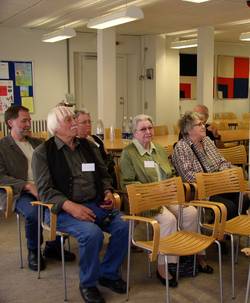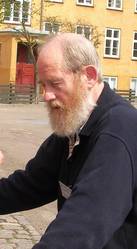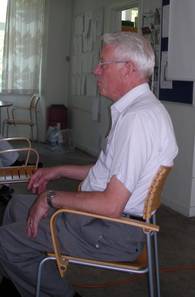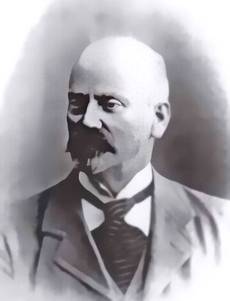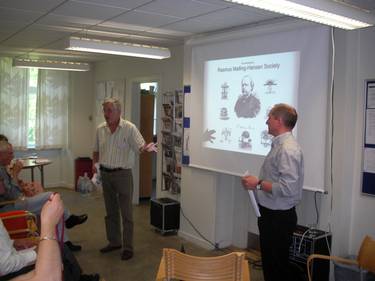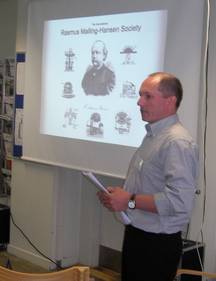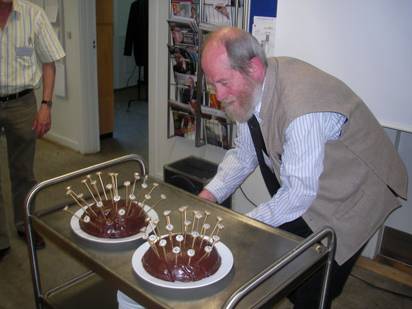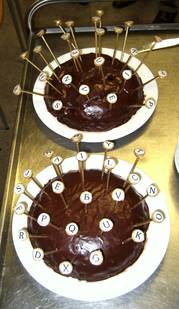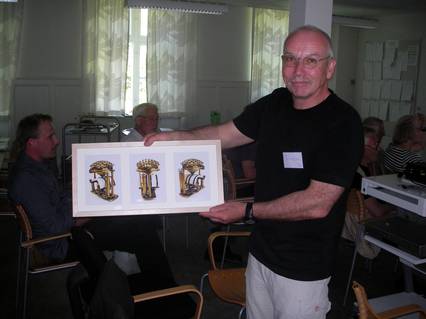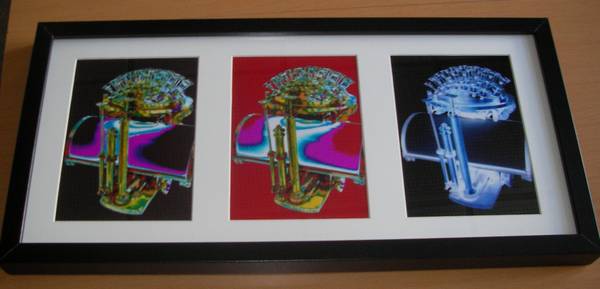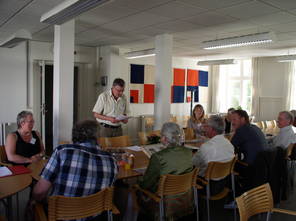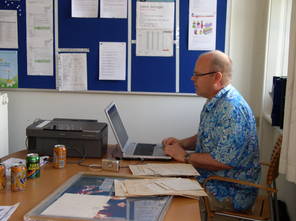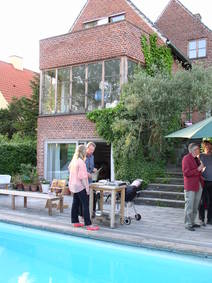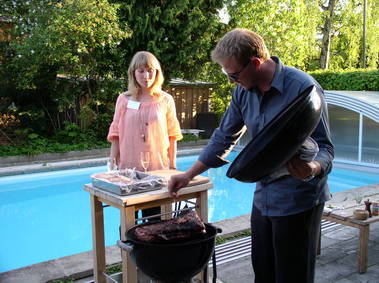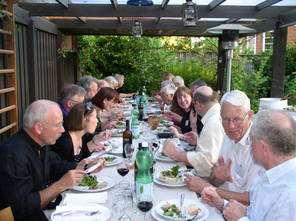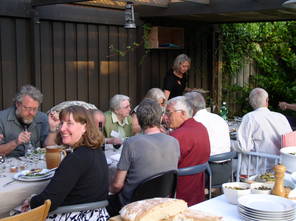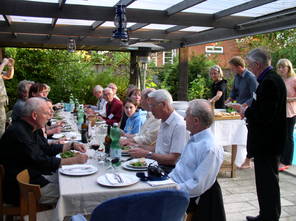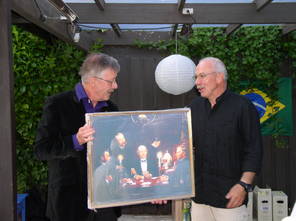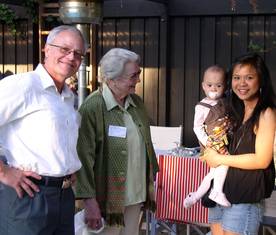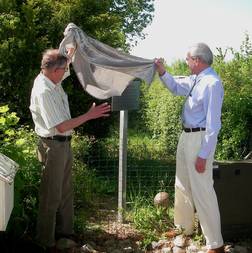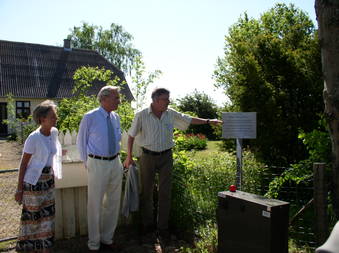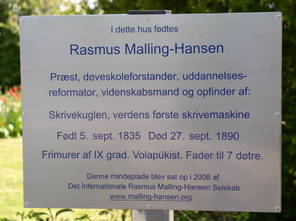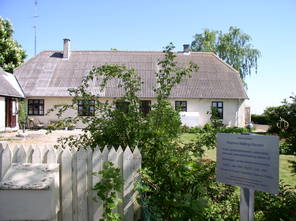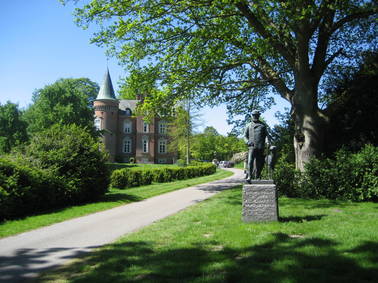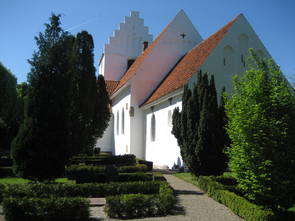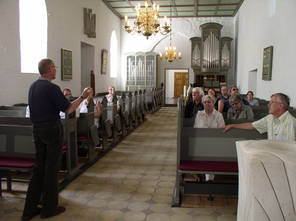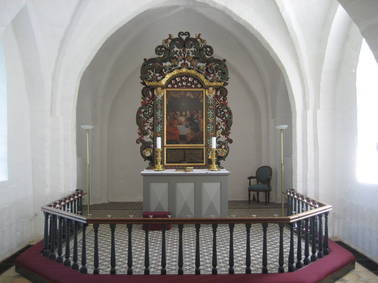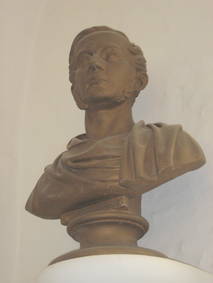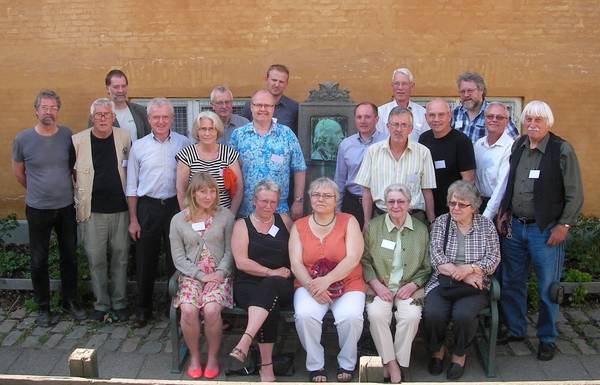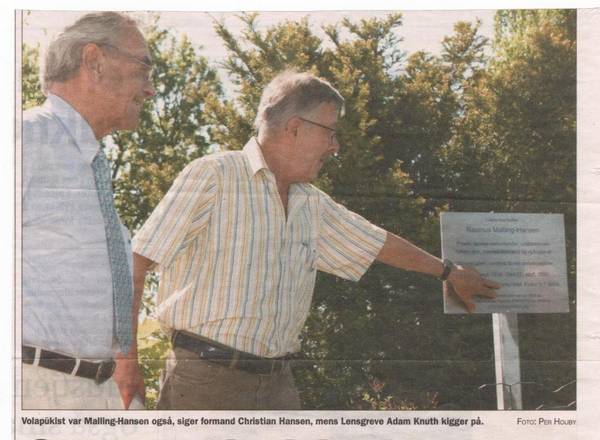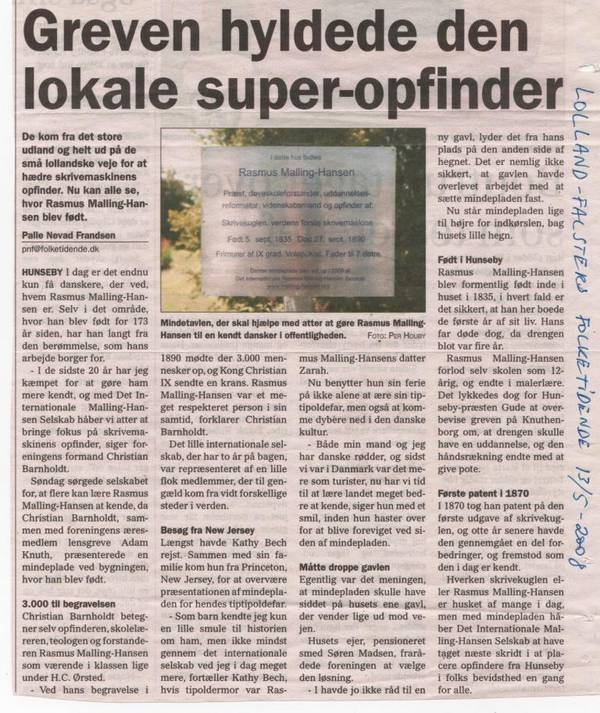The General assembly in Copenhagen, 2008
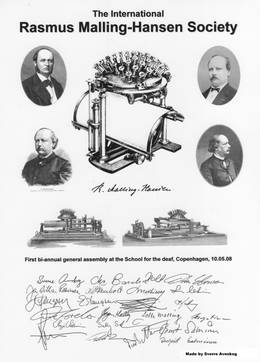
- The first bi-annual General Assembly took place at the 10.th of May 2008 in the old school of Malling-Hansen, the former Royal Institute for the deaf-mutes in Kastelvej of Copenhagen. All the participants signed this memory poster from the meeting. Copyright: Sverre Avnskog
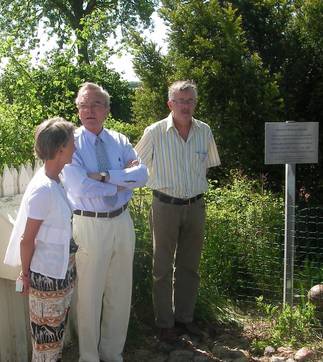
- One of the many highlights from the weekend, was the unveiling of the plate in memory of Malling-Hansen in front of the house where he was born in Hunseby, in the south of Denmark. The unveiling was conducted by the president of the Society, and the present Count of Knuthenborg and his wife. Photo: Sverre Avnskog
In May 2008 it was time for the second great event in the history of The International Rasmus Malling-Hansen Society. Once again the members gathered in Copenhagen on Malling-Hansen's old school, and as two years before at the Founding Meeting, a wonderful weather in Copenhagen greeted us welcome.
Now it was time for the first bi-annual General Assembly, and more that 30 people from USA and several countries in Europe attended the event, which lasted for two days. As two years before, Jan William Rasmussen of "Døvehistorisk Selskab", had reserved localities at the School for the deaf for us, and an exhibition of Malling-Hansen items and documents was set up before the beginning of the meeting. It later also turned out that Jan William Rasmussen had prepared a special exhibition in the Museum in the basement of the school of old Malling-Hansen letters and documents and several other things showing the life of the pupils and the history of the teaching of the deaf in Denmark. This was a truly fantastic experience for the interested attendants - and could only be described as a gold mine for the Malling-Hansen research!
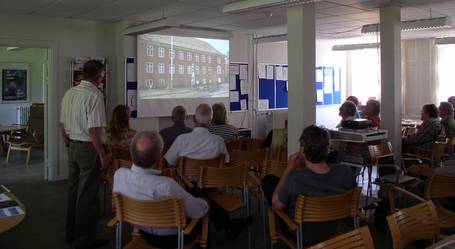
- The first point on the program, was an exciting movie about the life and work of RMH, made by Jan William Rasmussen and his son, Thomas William Rasmussen. The movie can be watched at the homepage of The Historic Society of the Deaf, where Jan William for many years has been the leading force. The comments was written and read by Jan William, and showed many interesting aspects of the development of the education of the deaf, and of the multi faceted personality of Malling-Hansen. Jan William has done a large work to make the history of the education of the deaf known, and a visit to the website he has built up together with his son, Thomas William is highly recommended. See their Malling-Hansen movie on this link: www.dovehistoriskselskab.dk/index.php Photo: Dieter Eberwein
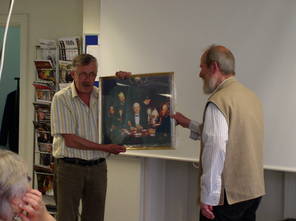
- The president of the RMH Society honored Jan William Rasmussen and showed the society's great thankfulness to him by donating him a copy of the famous painting of Malling-Hansen and his best friends playing l'Hombre in the home of Erik Ritzau. The original painting was made by Malthe Engelstedt in 1887, and is owned by Anna Ritzau in Kalunborg. It was exhibited on the large Industry- Agricultural- and Art exhibition in Copenhagen in 1888. Photo: Dieter Eberwein
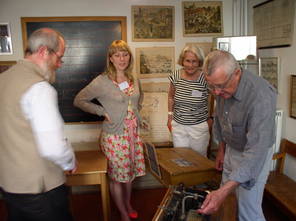
- Jan William also guided the participants on a tour around in the fantastic museum he has built up in the basement of the old institute. And he had prepared a special exhibition showing many new and unknown documents about the work of RMH. We could only take out our cameras and do our best to make copies to bring home with us, and luckily one of our vice presidents had also brought his scanner! Photo: Dieter Eberwein
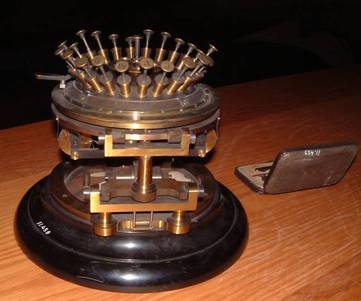
- "The crucial difference from the basic writing ball is that the ring with the 24 letter keys can be turned 360 degrees, independently of the underlying print rods and the central upper structure. This means that any one of the 24 letter keys can activate any one of the 24 print rods." From Mr. Faurholts article about the cryptographic writing ball. Photo: Niels Ole Faurholt.
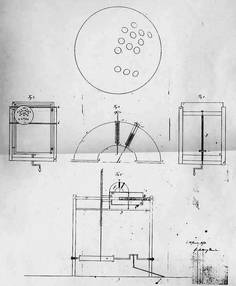
- The first patent drawing from January 1870 shows two different models of the writing ball - one with a flat paper-frame, that could be moved by the means of hand power, and one large table model with a sylinder that was set in circulation with the help of the foot
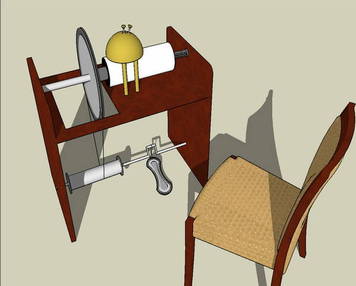
- A picture from Dieter Eberwein's 3D computer model of the table model. Was it ever built? We don't know for sure, but many sources state that the first writing ball model weighed 75 kg, and the first box-model only weighed 9 kg without batteries. At that time the most modern batteries weighed not more than 10 kg. Copyright: Dieter Eberwein
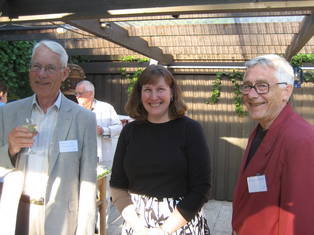
- Two Danish gentlemen are entertaining one of the female participants, who made probably the longest journey to take part in the event; Kate Bech, descendant from RMH's daughter Zarah, married to Fritz August Bech. The gentlemen are Nils Ole Faurholt(left) and Palle Westberg, former principal at the school for the deaf. Photo: Jørgen Malling Christensen
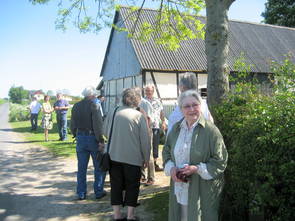
- After a good night's sleep and after a couple of hours drive to the southern part of Denmark, the members gathered again at the very house where Malling-Hansen was born in 1835, and spent his childhood. Lotte Malling and the other participants had to wait some minutes for the most prominent guests. Photo: Jørgen Malling Christensen

- And soon they arrived, the Count and Countess of Knuthenborg. Christopher Knuth's forefather, Frederik Marcus Knuth, was the economic benefactor of Malling-Hansen and of many other gifted local boys, and thanks to his economical support, Malling-Hansen was ably to study at the Jonstrup training collage for teachers and later to study theology. Lotte Malling wished the prominent couple welcome. Photo: Jørgen Malling Christensen

- The members of the Society listened with great interest to the exciting story about the Counts through the history, and especially of course, when it came to Frederik Marcus Knuth, RMH's benefactor. RMH also was the house teacher for the children of the Count and Countess for a year or so after he had finished his teacher's training course at Jonstrup. Photo: Dieter Eberwein
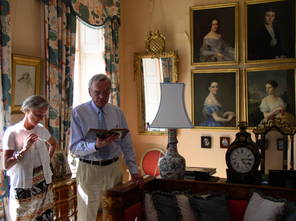
- The wall of the manor was decorated with old paintings of the persons that RMH very often wrote about in his letters. The Counts of Knuthenborg never became very old, and RMH had contact with at least three of them during his lifetime. One of them also donated a sum of money to the production of writing balls. Photo: Dieter Eberwein
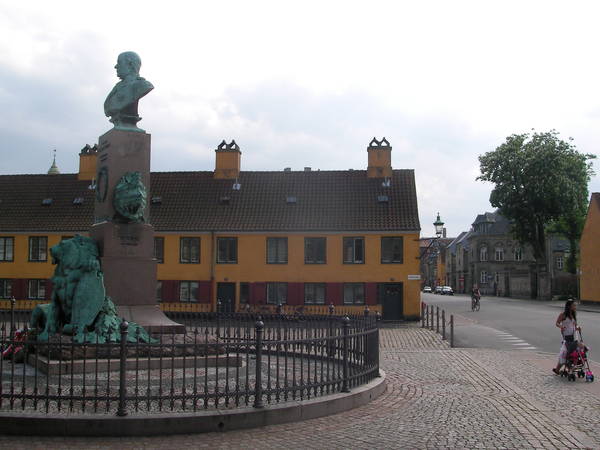
- The weeken soon approached its ending and our minds were filled with impressions from all the events. As for myself, I had a great whish to do just one more thing before I left Copenhagen this time. Since we had a couple of hours before our plane left, I managed to talk my wife into taking a walk along the rout that RMH followed at the last evening of his life. And I conclude this small presentation of the General Assembly 2008 with a photo of the place in Nyboder, Copenhagen, where RMH fell down on the ground on a dark September evening in 1890. He was walking along towards the viewer, when he was suddenly struck by a heart attach and fell dead to the ground. A doctor soon arrived at the place, but could only confirm that he was already dead, and his body was brought into the yellow building showed on the photo, which in those days had the address Leopardlængen. A great and eventful life was over, and so was a great weekend in Copenhagen for all the participants of The International Rasmus Malling-Hansen Society. Photo: Sverre Avnskog
View the movie from the General Assembly 2008 on this link to the website of Historical Society of the Deaf in Denmark:
http://www.dovehistoriskselskab.dk/index.php?id=94
Oslo, 22.05.10
Sverre Avnskog

